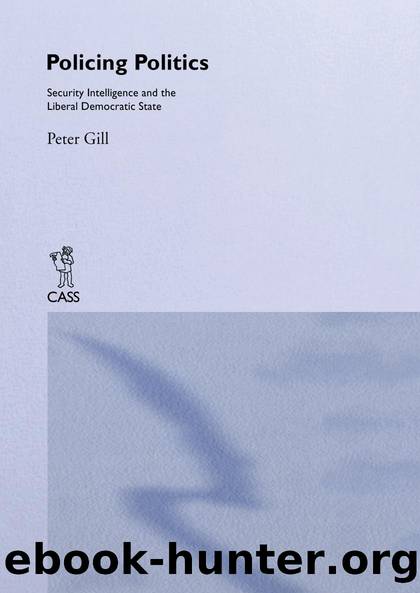Policing Politics by Peter Gill

Author:Peter Gill [Gill, Peter]
Language: eng
Format: epub
ISBN: 9780714640976
Barnesnoble:
Publisher: Taylor & Francis
Published: 1994-02-01T00:00:00+00:00
5
Penetration II: Producing Intelligence
This chapter is concerned with what security intelligence agencies do with the information which they gather. There are numerous possibilities but they will all involve some way of determining what, if anything, the information means and, second, what should be done with it. Should it be communicated elsewhere, should it be acted upon and, if so, in what way?
Production and Analysis
The early part of this process may be almost entirely technical, for example, transcribing tapes from telephone intercepts and preparing material for storage and retrieval; but it may be also evaluative, for example, translating documents and interpreting photographs.1 It is at the analysis stage that 'information' is converted into 'intelligence'. Since 'facts' rarely, if ever, speak for themselves, the analysts' ability to draw defensible conclusions from variously sourced information is centrally important. Yet it lacks the glamour of clandestine activities and the high-tech of exotic collection systems and a tendency to underestimate its significance has been noted in many intelligence agencies. For example, the CIA rapidly moved after its inception into covert activities contrary to what many had expected of the new agency and this resulted in future years in a relative downgrading of the status of analysts.2
When disseminating its product to other agencies which may be required to act on it, the security intelligence agency needs to be able to state clearly what it thinks the information means and to present it in a way which will attract the attention of 'customers'. One key role for analysts is to evaluate the information received, for example attempting to eliminate any 'disinformation' intended to mislead the agency. Regarding foreign intelligence it seems to be accepted that, in principle, competitive approaches between analytic groups will produce the best product; for example, they will be best at challenging 'groupthink' (for discussion of this seeChapter 6). Yet the requirements of policy-makers for guidance may mean that in practice the structure which develops is aimed at the production of a consensus assessment. An example of this is the production of National Intelligence Estimates (NIE) in the US, where agencies may register their dissent from any memoranda via footnotes.3
McDonald's main criticism of the way in which analysis had been conducted within the RCMP Security Service was that the product concentrated too much on providing covertly collected material on specific groups and individuals, and that it had been weakest in providing strategic, longer-term analysis which requires attention to both overt and covert sources of information.4 Three years after the separation out of the CSIS, SIRC noted in its annual report that the Service still appeared to be too dominated by the case approach of 'streetwise' intelligence officers rather than the longer term analysis recommended by McDonald. This was aggravated by the persisting tendency of CSIS to recruit intelligence officers from the ranks of former police officers.5 Three years later, however, the Commons Special Review Committee commended CSIS for the progress it had made in improving its strategic analytical capacity.6
Other problems can arise from the different personalities attracted to analysis rather than policy or executive roles.
Download
This site does not store any files on its server. We only index and link to content provided by other sites. Please contact the content providers to delete copyright contents if any and email us, we'll remove relevant links or contents immediately.
| Espionage | Hoaxes & Deceptions |
| Murder & Mayhem | Organized Crime |
| Serial Killers | White Collar Crime |
Mindhunter: Inside the FBI's Elite Serial Crime Unit by John E. Douglas & Mark Olshaker(9263)
Wiseguy by Nicholas Pileggi(5708)
Room 212 by Kate Stewart(5071)
Hitman by Howie Carr(5042)
Secrecy World by Jake Bernstein(4700)
Killers of the Flower Moon: The Osage Murders and the Birth of the FBI by David Grann(4409)
Papillon (English) by Henri Charrière(4227)
Breaking Free by Rachel Jeffs(4195)
Killers of the Flower Moon by David Grann(3996)
Say Nothing by Patrick Radden Keefe(3937)
American Kingpin by Nick Bilton(3819)
The Secret Barrister by The Secret Barrister(3661)
Molly's Game: From Hollywood's Elite to Wall Street's Billionaire Boys Club, My High-Stakes Adventure in the World of Underground Poker by Molly Bloom(3510)
Mysteries by Colin Wilson(3420)
In Cold Blood by Truman Capote(3346)
Signature in the Cell: DNA and the Evidence for Intelligent Design by Stephen C. Meyer(3098)
I'll Be Gone in the Dark by Michelle McNamara(3054)
Rogue Trader by Leeson Nick(3010)
Bunk by Kevin Young(2970)
